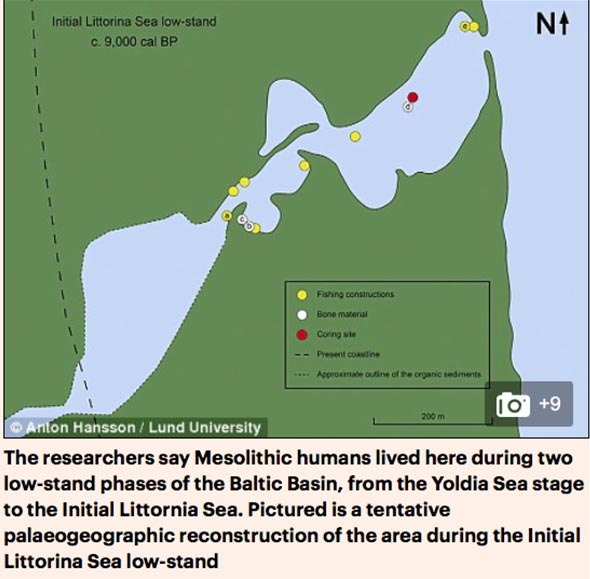

The 'Stone Age Atlantis': Stunning video reveals the 9,000-year-old settlement found submerged under the sea off Sweden Daily Mail - November 14, 2016
Just off the coast of southern Sweden, researchers have discovered what is thought to be the submerged remains of an ancient Stone Age lagoon community. The findings include a 9,000-year-old pick axe sculpted from elk antlers, and eight fish traps made of braided hazel rods. According to the researchers, the settlers that once lived there likely had good lives, with plenty of food and a favorable climate - but their lagoon environment sank as sea levels rose in the centuries that followed.

Just off the coast of southern Sweden, researchers have discovered what's thought to be the submerged remains of an ancient Stone Age lagoon community. According to the researchers, the lagoon environment sank as sea levels rose Since divers first discovered the oldest known stationary fish traps in northern Europe six years ago, researchers at the Lund University in Sweden have revealed the site to be a Stone Age relic. The researchers say that 9,000 years ago, this was an old lagoon environment where Mesolithic humans spent parts of the year.
Researchers discovered the wood remains and archaeological artifacts up to three kilometers off the modern coast of the Baltic Sea at Havang. These relics were found at least 20 meters below the sea, and are exceptionally well-preserved, dating back roughly 9,000 years. The researchers say these ancient people‘had quite good lives here. There was lots of food and quite warm climate, at least during the summers.
As humans have long preferred to live near the coasts, the researchers say submerged settlements such as this are common, due to rising sea levels that swallowed them in the later centuries. According to the team, this site off southern Sweden was likely once a lagoon environment surrounded by a pine-dominated forest. They say Mesolithic humans lived here during two low-stand phases of the Baltic Basin, from the Yoldia Sea stage to the Initial Littornia Sea.
If you want to understand fully how humans dispersed from Africa and how they lived their lives, we also have to find all their settlements, said Anton Hansson, PhD student in Quaternary geology at Lund University. And quite a few of their settlements are, today, underwater because during the last glaciation sea level was quite a lot lower than today.
Humans have always preferred coastal sites, as we do today. The discovery outside the Verkean River mouth is of both archaeological and geologic importance. The elk antler pick axe found at the site is nearly 9,000 years old and is covered in very interesting inscriptions.
The team discovered fish traps made of braided hazel rods dating back 9,000 to 8,500 years. These, like the one pictured above, were found all over the area, and were used to catch fish.
Just off the coast of southern Sweden, researchers have discovered what is thought to be the submerged remains of an ancient Stone Age lagoon community. The findings include a 9,000-year-old pick axe sculpted from elk antlers, and eight fish traps made of braided hazel rods. According to the researchers, the settlers that once lived there likely had good lives, with plenty of food and a favorable climate - but their lagoon environment sank as sea levels rose in the centuries that followed.